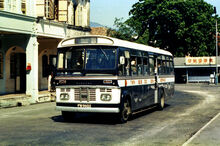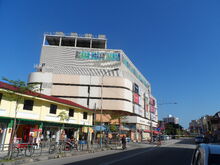
Brick Kiln Road (Jalan Gurdwara), George Town
Brick Kiln Road stretches from the heart of George Town south towards the Pinang River. Part of the Seven Streets Precint (chit tiau lor in Penang Hokkien), it links the Magazine Circus to the north with Bridge Street, just before the Pinang River Bridge, to the south.
In the late 19th. century, Brick Kiln Road was so named due to a brick kiln located at the road. At the time, it was home to an industrial, working-class community, mostly of Sikh and Chinese descent. It was part of George Town's Seven Streets Precint (chit tiau lor in Penang Hokkien), while the Diamond Jubilee Sikh Gurdwara was once the largest in Southeast Asia. The road was later officially renamed Gurdwara Road, taking its name from the Sikh temple.

A bilingual Brick Kiln Road sign. The road's official Malay name is Jalan Gurdwara.
Following the burgeoning street art scene in George Town since its listing as a UNESCO World Heritage Site in 2008, the former Hin Bus Depot at the road has been converted into an art gallery. Street art exhibitions have been periodically held inside the former bus depot.
In recent years, local Penangites have expressed concerns about the influx of low-skilled foreign workers along Brick Kiln Road. This foreign influence can be clearly seen along the northern stretch of the road near GAMA Supermarket and Departmental Store, where many shops have been taken over by Bangladeshi, Nepali and Burmese workers. Some have dubbed this particular area as Penang's 'Little Bangladesh'.
Etymology[]
Brick Kiln Road was named after a brick kiln that used to be located at the road in the late 19th. century. The Malays also referred to the road as Bakar Bata, meaning burnt bricks.
In the past, windmills, which were used for rice milling, were installed along the road, giving the road its Hokkien name Hong3 Chia3 Lor33 (Windmill Road).
In recognition of the contribution of the Sikh community on Penang Island, Brick Kiln Road has been officially renamed Jalan Gurdwara ('Gurdwara Road' in Malay). It takes its name from the Diamond Jubilee Sikh Gurdwara along the road.
History[]

A tram at Magazine Circus, the northern end of Brick Kiln Road, in the late 19th. century
Brick Kiln Road, named after a brick kiln that used to operate along the road, has been in existence since the late 19th. century. The road was created as George Town was expanding southward beyond the Prangin Canal. Initially a rural road leading south from Penang Road, it became home to an industrial, working class community.
The Sikhs, who had been recruited as paramilitary officers by Captain Tristram Charles Sawyer Speedy to quell tin-related violence in the neighbouring Sultanate of Perak, began to populate the road in the 1880s. A police barracks for the Sikh was also built along the road.

Diamond Jubilee Sikh Gurdwara was once the largest Sikh temple in Southeast Asia. The official name of the road, Jalan Gurdwara, was also taken from the Gurdwara.
In 1897, during Queen Victoria's Diamond Jubilee, the Straits Settlements government donated a plot of land along Brick Kiln Road to the Sikh community. The Sikhs subsequently built the Diamond Jubilee Sikh Gurdwara on the land, financed by donations from the Sikh members of the Malay States Guides. Upon its completion in 1899, the Sikh temple was the largest in Southeast Asia.
In the past, tourists and travellers were provided food and accommodation at the Gurdwara free-of-charge. This was in accordance with Sikh teachings, which espoused kindness and helping others regardless of race and religion.

The police station at the northern end of Brick Kiln Road was demolished in the 1970s to make way for GAMA Supermarket & Departmental Store.
Other than that, Brick Kiln Road formed the western edge of George Town's Seven Streets Precint (chit tiau lor in Penang Hokkien). The precint includes nine (initially seven) streets that run parallel to the Prangin Canal.

GAMA Supermarket & Departmental Store, at the northern end of Brick Kiln Road, was completed in 1980.
In the 1970s, the old police station at the northern end of Brick Kiln Road was demolished to give way for the construction of GAMA Supermarket & Departmental Store. When it was opened in 1980, GAMA was the first modern departmental store on Penang Island. It subsequently became a popular retail destination in George Town until the 2000s.

A bus owned by the now-defunct Hin Bus Company in the late 20th. century. Today, its depot at Brick Kiln Road has been converted into a street art gallery.
To tap into the burgeoning street art scene in George Town, the former Hin Bus Depot has been converted into a street art gallery, where street art exhibitions are periodically held.

Most of the shops along this stretch of Brick Kiln Road have been taken over by Bangladeshi, Nepali and Burmese workers, raising concern amongst local Penangites.
More recently, there has been an influx of low-skilled foreign labourers, mainly from Bangladesh, Nepal and Myanmar, at Brick Kiln Road. Most of the shops along the northern stretch of Brick Kiln Road near GAMA Supermarket & Departmental Store have been taken over by these foreign workers, leading some local Penangites to call this particular area 'Little Bangladesh'. This has generated unease amongst Penangites, who fear the proliferation of foreign-owned eateries and sundry shops, as well as the potential risks of crime.

Hin Bus Depot Art Centre, formerly Hin Bus Depot, now houses street art exhibits.
Notable Landmark[]

A street art exhibit inside the Hin Bus Depot Art Centre.
Hin Bus Depot Art Centre
Religion[]
- Diamond Jubilee Sikh Gurdwara
- Phu Thor Yen Buddhist Temple
Food[]
- Deen Maju Nasi Kandar
- Kedai Nasi Kandar Wonderlite
- Ang Huay Lor Restaurant
- Ju Bao Lou Cafe
- Bin Sin Coffee Shop

Shopping[]
GAMA Supermarket & Departmental Store
Hotel[]
Hotel Neo
Political Representation[]
Penang State Government[]
Western side
N.28 Komtar State Assemblyman : Teh Lai Heng (Democratic Action Party)
Eastern side
N.27 Pengkalan Kota State Assemblyman : Lau Keng Ee (Democratic Action Party)
Malaysian Federal Parliament[]
P.049 Tanjong Member of Parliament : Ng Wei Aik (Democratic Action Party)
References[]
- Khoo S.N., 2007. Streets of George Town, Penang. Areca Books.
- http://www.penang-traveltips.com/brick-kiln-road.htm
- http://www.thestar.com.my/metro/community/2016/02/16/locals-worried-about-foreign-influx-they-fear-some-areas-will-be-taken-over-by-outsiders/
- http://ktemockongsamkok.blogspot.my/2016/04/the-day-i-first-saw-my-mum-cry.html
- Francis, R., Ganley, C., 2006. Penang Trams, Trolleybuses & Railways: Municipal Transport History, 1880s-1963. Areca Books.
- http://www.themalaymailonline.com/eat-drink/article/ang-hoay-lor-the-true-taste-of-hokkien-cuisine-in-penang